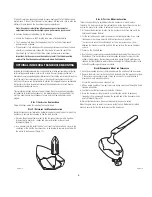
Two components need to be installed on the boat: the transducer and the control
head. The control head displays sonar information, the transducer sends and
receives sonar signals into the water. Proper installation of each insures best per-
formance of the Piranha and provides the greatest enjoyment and functionality.
Due to the wide variety of boats only general instructions are presented in
this installation guide. Each boat has unique characteristics that need to be
evaluated.
INSTALLING THE TRANSDUCER
S
TEP
1: D
ETERMINE
T
RANSDUCER
L
OCATION
Consider the following to find the best location on the transom:
Choose an area free of turbulent water.
• Turbulence is generated as the boat moves through the water and is confined to
area aft of ribs, strakes and rivet lines on the bottom of hull. Choose a location
on the transom where the hull forward of this location is smooth, flat and free of
protrusions or ribs.
• Turbulence is also created by the prop - try to keep at least 15” (380mm) from
the prop(s).
• The best method to locate areas free of turbulence is to watch the transom
while the boat is moving. For best high-speed performance this is
recommended. Have an assistant pilot the boat and use caution!
• Stepped hulls require the transducer be mounted on the step if possible. Never
mount the transducer on the transom behind the step.
• If propellers are forward of the transom, clear water may be impossible to find. A
different transducer or mounting method should be considered, (see optional
inside hull instructions below).
• The mounting area must be in contact with the water when the boat is on plane.
• If the boat is trailered, make sure that the transducer is not inline with trailer
bunks or roller assembles that could damage the transducer during loading
operations.
S
TEP
2:
FOR
T
RANSOM
M
OUNTING
: D
RILL THE
M
OUNTING
H
OLES
1. Remove the mounting template from the inside of the package printing. This
template provides a means of locating the two mounting holes which must be
drilled.
2. Hold the template on the transom of the boat in the location where the
transducer will be installed. Align the template vertically with the inside arrow of
the template on the deadrise where the bottom of the hull meets the transom
wall. (Figure 3 ).
3. Using a pencil or punch, mark the location of the two mounting holes on the
transom.
4. Using a
⁵⁄₃₂
"(4mm) bit, drill the two holes to a depth of approximately 1" (3cm). On
fiberglass hulls, it is best to start with a smaller bit and use progressively larger
drill bits to reduce the chance of chipping or flaking the outer coating.
S
TEP
3: A
SSEMBLE
& M
OUNT THE
T
RANSDUCER
1. Attach the Pivot to the transducer body, as shown in (Figure 4), using the #8 -
³⁄₈
" (9mm) long allen headed pivot screw, the headed pin, the two flat washers,
and the two toothed lock washers.
Note: The toothed lock washers must be positioned between the
transducer and the pivot ears. The flat washers must be positioned to the
outside of the pivot ears.
2. Using the Allen wrenches provided, loosely tighten the pivot screw (Figure 6). Do
not completely tighten the assembly at this time, so the pivot angle can be
adjusted later.
3. Insert the pivot/transducer assembly into the mounting bracket, as shown in
(Figure 4).
Do not snap the assembly closed.
PIRANHA 5 INSTALLATION GUIDE
You will need: Hand drill and various bits, Phillips #2 & 3 drivers, pencil, silicone sealant (for drilled
holes), 2-part, slow cure epoxy for inside hull transducer mounting, 12v DC power supply, 1 ampere
fuse.
Figure 1. Mounting locations include transom and inside hull.
DO NOT LET DEADRISE
INTERSECT THIS LINE
PLACE EITHER CORNER
ON DEADRISE ANGLE
TOP
Use 5/32" drill bit
Drill
Drill
PLACE EITHER CORNER
ON DEADRISE ANGLE
TOP
Use 5/32" drill bit
Drill
Drill
Level
Figure 3
Figure 4
Mounting Bracket
Pivot
Transducer
Pivot Bolt
Washer (2)
Cable
Star Washers go between
pivot and transducer.





